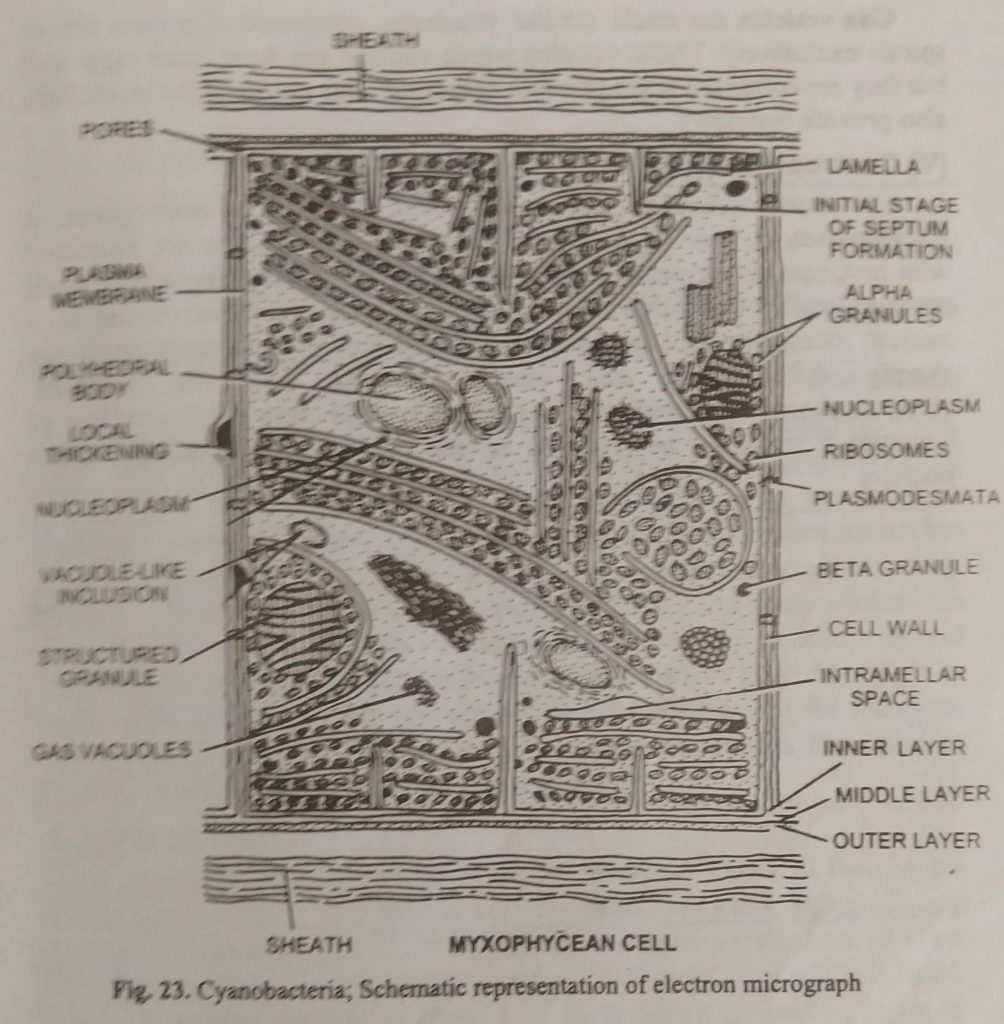Q.2. Describe the cell structure of cyanobacteria.
Ans. Cells of cyanobacteria may occur singly, enclosed within a mucilaginous envelope (e.g., Gleocapsa, Microcystis) or form chains called trichomes (e.g., Oscillatoria, Gloeotricha) or as a sheet (e.g., Dermocarpa). The filament consists of one or more trichomes enveloped in a gelatinous sheath. (BSC Notes)
The cell shows a typical procaryotic structure. There are no membrane-limited organneles within the cells although a variety of vesicles and inclusions may be present. The cytoplasm is surrounded by a plasma membrane, followed by a firm cell wall and a mucilage sheath.
[I] Mucilage Sheath
The cell wall of cyanobacteria is surrounded by a thin (e.g., Anacystis montana) or thick (e.g., Anabaena) mucilage sheath, also known as a slime layer or capsule. In unicellular forms, each individual has a distinct sheath of its own, whereas in filamentous forms there is a common gelatinous sheath. The sheath is composed of a complex mixture of mucopolysaccharides and glucuronic acid. It is made up of fibres, held together in the mucilage. The fibres arise from the cell wall but are too firmly attached to it and as such, the trichome may turn within the sheath.
The orientation of fibres varies in different species. The mucilage sheath probably helps in protecting the cells from desiccation, particularly in those species which do not produce resistant spores. It also helps in gliding movements.
[II] Cell wall
The cell wall of cyanobacteria is thin and firm and is basically similar to that of Gram-negative bacteria. It is differentiated into four layers which are designated as LI, LII, LII, and LIV, LI, being the innermost lying next to the plasma membrane and LIV the outermost. The cell wall is made up of peptidoglycan together with carbohydrates, amino-acid and fatty acids.
[III] Cytoplasmic membrane
It forms the limiting membrane of the cytoplasm and is made up of protein lipid-protein layers. It has many infoldings which penetrate the cytoplasm. It has been suggested that these infoldings give rise to new pigment-containing thylakoids.
[IV] Chromatoplasm
It is the peripheral pigmented portion of the protoplast and has a reticulate, alveolar, or homogeneous structure. The chromatogram is characterized by the presence of flattened vesicular structures, called thylakoids or photosynthesis lamellae. Each lamella is composed of two membranes joined at the ends and enclosing an intrathylakoid space of 70-80 A width. The lamellae thus form closed flattened sacs which contain chlorophylla, carotenoids, and three phycobiliproteins; c-phycocyanin, allophycocyanin, and c-phycoer thrin.
The thylakoids are arranged in parallel rows close to the periphery of the cell or they are distributed irregularly throughout the cell. Thus, the pigments are not contained in true membrane-limited plastics.

The photosynthetic lamellae of cyanobacteria are considered by many also the sites of cellular respiration and as such, they are preferably called photosynthetic respiratory membranes. The cells of cyanobacteria are devoid of Golgi apparatus, mitochondria, endoplasmic reticulum, and other membrane-bound organelles.
In addition to thylakoids, chromatoplasm contains protein granules and gas and oil vesicles. (BSc 1st Year Botany Eukaryotic Algal Cell Sample Model Practice Question Answer Papers)
Cyanophycin granules, also known as structured granules, are irregular or polyhedral in shape and they store protein in the form of polypeptides.
Polyhedral bodies are angular in shape and are usually associated with the DNA in the central part of the cell. They are considered to be the carboxysomes that store the carbon dioxide-fising enzyme ribulose 1, 5-bisphosphate carboxylase.
Polyphosphate bodies, also known as volutin granules, are small spherical structures, located near the centre of the cell. They store phosphate and are found abundantly in mature cells grown in a medium with high phosphate contents. (BSc 1st Year Botany Eukaryotic Algal Cell Sample Model Practice Question Answer Papers)
Gas vesicles are small, tubular structures, composed of protein ribs or spirals exclusively. (BSc 1st Year Botany Eukaryotic Algal Cell Sample Model Practice Question Answer Papers)
These vesicles which contain gas have quite a rigid wall but they are collapsed when pressure is applied. The gas vacuoles shield light and also provides buoyancy. (BSc 1st Year Botany Eukaryotic Algal Cell Sample Model Practice Question Answer Papers)
[V] Centroplasm
The central colourless region of the cell is known as centroplasm or nucleoplasm. It consists of several naked DNA which is not associated with histones. However, in some cyanobacteria, a histone-like protein binds nonspecifically with DNA. The nuclear material is not surrounded by a nuclear membrane and nucleoli are also absent. (BSc 1st Year Botany Eukaryotic Algal Cell Sample Model Practice Question Answer Papers)
The nucleoplasm is not sharply differentiated and usually intrudes into the peripheral chromatoplasm. Although this region stains like that of the nucleus of eucaryotes, it cannot be regarded as the true nucleus and is called the incipient nucleus. (BSc 1st Year Botany Eukaryotic Algal Cell Sample Model Practice Question Answer Papers)
BSc 1st Year Botany Eukaryotic Algal Cell Sample Model Practice Question Answer Papers
BSc 1st Year Botany Eukaryotic Algal Cell Sample Model Practice Question Answer Papers
BSc 1st Year Sample Model Practice Mock Test Question Answer Papers